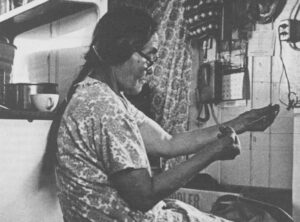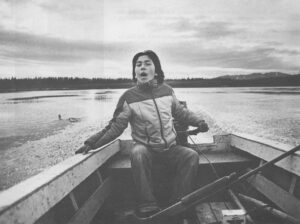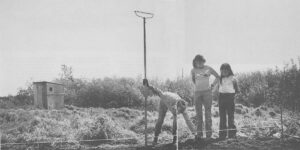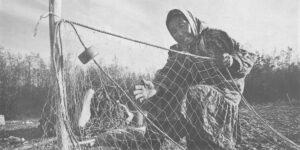The Mine and the Meeting
(SHUNGNAK, ALASKA) — To hear Charlie Lee tell it, it was quite a night. “Day shift, night shift, day shift, we was really working,” he remembers. “It was fall time. They was about to close down the camp. At night, after everybody go to bed, I heard a lot of shouting. I thought something was wrong down there, lots of fellows hollering. The day shift had gone off. That night shift started drilling a little, and they found copper. Boy they was really happy. Go wake up the boss. Hollering, wake up everybody in camp. The boss run around with no pants on, in his underwear. Everybody happy. That was the first they find at Bornite.”
Charlie Lee is 79 now, living in the Eskimo village of Shungnak on the Kobuk River in northvvest Alaska. More than 20 years ago, he was a summer employee of Bear Creek Mining, exploring the southern flanks of the Brooks Range near Shungnak. Now a subsidiary of Kennecott Copper Corporation, Bear Creek found some of the world’s richest copper ore — 25 percent equivalent copper compared to 0.5 percent at some other sites. That was reason to be happy, if you were a copper company.

Today, Bornite is deserted. A mining tower stands over a 1,000 foot vertical shaft. A dormitory nestles into the hillside above the machine shop. Equipment stands nearly covered by huge drifts of snow. For all its promise, Bornite remains largely untapped. Homer Cleveland is the only Shungnak Eskimo who works here now, as a watchman. In the summer, Kennecott sends 20 or so geologists and technicians to keep tabs on the claims and poke around the mountains. All that rich copper ore is still buried. Why? There are several reasons. The Alaska Land Bill is as yet unresolved. There are no roads within 200 miles. The ore itself, though rich, is scattered in pockets. The only shaft at Bornite now is flooded with water, which had to be pumped at the rate of 25,000 gallons a minute \vhen the shaft was in use. Finally, world-wide coppet prices haven’t been high enough to make this all worthwhile. So Kennecott waits, while Homer Cleveland is the keeper of Bornite’s treasures.
Bornite Camp
Homer and I were finishing lunch in the watchman’s cabin at Bornite Camp when a small grey bird flew by the window and lighted on the snow nearby. Homer walked to the window, opened it, and broke a few cracker crumbs on the snow below. “I always feed these camp robbers pancakes in the morning,” he said, leaning over the sill to watch the robber come back for lunch. “Last fall, I was skinning a caribou outside, you know, and set the hide over to the side. Them camp robbers started coming in and eating the fat. So I set a mouse trap, to scare ’em. But one, I catch his leg. Now his leg’s broken, so I feed him pancakes in the morning. He still flying around.” Homer chuckled and bent his finger, broken.
“Much game around here?”
“Oh, sure…look here.” He pointed to scratches in the wall below the window. “Bear.” Homer told how a bear crawled in through the window, ransacked the place, scattered groceries all over and, as a final insult, left a calling card on the floor. “The place sure stink.” Homer said, cursing. The bear was soon back, this time at night with Homer inside, and Homer didn’t get much sleep. So he told his boss. Instead of shooting the bear, the men rigged two rods under the window and wired them to a plug. At night Homer plugs them into the electricity. No more bears.
“Caribou?” I asked.
“Must have millions of caribou here this fall. Walking right through camp. Millions.” Homer laughed, remembering how his young grandson wanted him to shoot them all. He took three for the winter, cutting them up to the camp robbers’ delight. Homer leaned back in his chair, remembering all those caribou. Outside, the sun was sliding nearer the peak of Cosmos Mountain. Already, the lower part of the camp was in shadow, although the metal-clad tower over the mine shaft caught the sun and scattered it across the snow. The view, even without “millions” of caribou, is impressive. Across the Ambler Valley to the north, the Brooks Range begins in earnest, sharp canyons, water falls sheathed in ice and snowy peaks never climbed. Nestled a little way up one of those valleys lies Arctic Deposit, also a Kennecott copper claim. The ore is not so rich, but also not so scattered and far easier to get at than Bornite.
Kennecott isn’t the only mining company up here. Anaconda has a camp not too far away, as do two other companies. Mining is a familiar companion to Kobuk River Eskimos. In the gold rush of 1898, the creeks were swarming with thousands of prospectors. Most left after one winter. Eskimos themselves have been mining and prospecting in a small way. This part of Alaska is so rugged and remote, this climate is so hostile, that much of it remains unexplored. Who knows what will be found here next year…. To all this most Eskimos turn a half-interested ear. Mining means occasional jobs. Exploration doesn’t frighten much game. Miners invariably leave for the winter, six months gone.
Homer notes that a white man was the first to find copper ore in an abandoned gold mine. He staked claim and later sold the claim for several million dollars. Until the passage of the Alaska Native Claims Settlement Act in 1971, all this was considered federal land, even though the Eskimos had used it for centuries and never sold it, traded it or lost it in battle. It was open for claims and homesteads. In Eskimo society, land wasn’t owned, it belonged to everyone. A plot was “yours” as long as you used it. The value of land lay in its ability to support life. Land meant fish camps and winter camps, wolverine and caribou, birch and willow. So no Eskimo staked a single claim at Bornite camp. The only profit they stand to make from mining now will be wage labor. When NANA made its land selections, Bornite was spoken for. Yet you rarely hear an Eskimo upset about not owning all that copper. They’re far more interested in other things.
“One fall,” Homer remembers, “there was no caribou around here. Those camp robbers came to my window and one of them I tell, ‘I sure could use some caribou meat. Why don’t you go bring some nice fat bull caribou over here. I’ll let you have some of the fat.’ I tell that to my bosses and they just laugh. They don’t believe me. That afternoon, I look down the road and here come two bull caribou. One, he goes by, but the other stops and looks right at me. Then he starts walking to me….”
“I share the fat with the camp robbers. My boss, they still never believe me.”
The Meeting
Almost everyone in Shungnak came to the meeting. Adults sat in too-small school desks, knees scrunched and elbows askew. Others aligned their backs with the walls of the classroom, while kids sat on a counter in back or leaned against the door frame. The oldest villagers who could still get around were there, and the youngest toddlers, too. While the setting was twentieth century modern-fluorescent lights and formica tables — the clothing was timeless. Some wore mukluks of caribou and seal skin, hand sewn. Wolfskin ruffs framed brown faces. And some wore Levis, flannel shirts, Sorel pac boots and Eddie Bauer down parkas.
John Schaeffer was in charge, dressed in blue jeans and a collarless linen shirt. He looked like anything but what he was, the president of a $60 million corporation. And the people arrayed before him were, appearances notwithstanding, stockholders in that corporation, the NANA Regional Corporation of Kotzebue, Alaska. Schaeffer was here to present NANA’s annual report and to distribute earnings.
These Eskimos collectively own a three-story hotel, a modern Eskimo museum, the largest oil drill rig in operation on the North Slope, drilling rights in the Beaufort Sea, a private security force in Anchorage and millions of acres of prime Alaskan wilderness. Yet they are not wealthy people. They qualify, almost to a family, for low income federal housing. Some are eligible for food stamps, others for BIA assistance.
The Changing Village: |
|
 |
Rolling barrels of fuel up to the Village |
 |
NANA’s stockholder ineeting |
 |
NANA’s stockholder ineeting |
The much proclaimed Alaska Native Claims Settlement Act hasn’t made them cash rich, although NANA was the fifth most profitable of the 13 native corporations last year and expects to be second or third this year. Most shareholders hold 200 shares. At 75 cents a share, every person in Shungnak eight years and older earned $150 last year. That buys electricity for one month or fuel oil for three weeks.
NANA’s wealth is in real estate, in the land its shareholders continue to use for hunting, fishing and camping. NANA is not mining it, developing it or selling it. To do any of these things could jeopardize the basis of village life — subsistence. Most of the people at the NANA meeting had just come from dinners of caribou or fish, perhaps with wild berries on the side. Processed food, like everything else in rural Alaska, is absurdly expensive. “We’re trying to maintain subsistence,” Schaeffer said one year ago. “We see no alternatives, not even intensive mining. The adverse effects are worse than the benefits, at least now. That has been the cornerstone of our land selection and management purposes…Our regional boundaries are based on subsistence use.”
One strategy NANA used was to surround Bornite Claim with its own land claims, effectively isolating it. If Kennecott wants to move ore over land from Bornite, it will need NANA’s cooperation. For eight years, NANA has been sitting tight on its land, although it has invested in oil operations on the North Slope in neighboring Arctic Slope Regions. During those eight years, the villages have been changing: new low-income houses, water and sewer, television, mortgages, bills and loans. The company realizes that today, as ever, its shareholders are very cash poor. It does its best to provide jobs as well as dividends. “We’ve got about $5 million invested in the region and we lose almost a million a year. We have about the same amount invested outside the region and we made almost $2.5 million.” The millions invested in the region — the hotel and the museum for example — provide jobs for Natives who might otherwise have none. But it’s not enough.
“Now that everybody’s got lights and housings,” Schaeffer told the meeting, “you need money. We’ve had steady jobs available, but our people see the geese fly over and they quit. So naluagmiu (white people) end up with those jobs. We looked at construction and fishing for jobs you could use. The only thing that will work up here is mining. We’ve stayed away from this up to now. Mining could hurt subsistence. It still can. But the jobs are needed, so we’re looking at it.
“Friday, I met with all the big mining companies, except one, who have claims in our region. We talked about when these companies were going to develop them. We can’t stop them, under U.S. law. They have valid claims. Two things have to come before they’ll pump any money in. One, land claims settled. Two, transportation arranged. Except for that, Bear Creek Mining, is ready to go. They could begin construction five years from now and go into production eight years from now. That’s the earliest. It’s a long ways down the road. That’s good, because that gives us time to prepare, if we decide that’s what we want to do. If they all went into production, there would be more than enough work for all of you.” NANA, Schaeffer explained, may be able to make some deals for Native hire and transportation corridors, in exchange for cooperation with mining companies.
”There are problems,” he warned. “Water can run off and pollute streams. That may kill fish. Some mines may have as many as 3,000 people. No self-respecting caribou will come anywhere near that. The hunting may not be so good. The mining companies are looking for a road to Fairbanks. The road will involve public funds and people will drive anywhere there is a road. You can’t control some tourist or hippy driving that road. I told them NANA wouldn’t let them build a road to the east (Fairbanks). But that is me talking. They asked me what we would think of a railroad. I told them we were not ready to look at that yet.
“You people need jobs. We shouldn’t delay them. But at the same time, I don’t want to put in something that’s going to hurt us. My worst fear is a road that would let people from Fairbanks come up here and hunt and fish along the way. They fly up here right here now to get your moose. What is going to happen if anybody can get in his car and come up?”
It was time for a vote. Of the sixty present, a majority wanted Schaeffer to cooperate with the mining companies. Not one wanted a road to Fairbanks. Options were discussed, and the best solution seemed to be a railroad west to Golovnin Bay near Nome. The ore could be loaded onto ocean vessels. The railroad wouldn’t tie Shungnak to any non-Native population centers. Leaving Shungnak the next day, Schaeffer would travel to ten other NANA region villages seeking options. He’s done this before, and each time a majority of the villages were against mining. But each year, more of his shareholders move from their free cabins into government housing, where they pay mortgages. They burn oil at $60 to $95 a drum instead of wood. Their electric bills run from $100 to $150 a month, at rates ten times those in the lower 48. They buy television sets now that satellite transmissions are available. TV tells them they want new clothes and new machines and processed foods and trips to Outside. Villages are feeling a big cash crunch.
The Road
At Bornite, Homer Cleveland put away the dishes and we gassed up the snow machines for the 16-mile ride home. The road, drifted in with ten feet of powder snow, took us up through Bornite Pass where caribou walk south on their fall migration. We emerged hundreds of feet above the Kobuk River Valley. Spread out for miles and miles was a snowy carpet of Arctic wilderness, spruce along the river, willows following the sloughs, caribou grazing on tundra hilltops and lynx stinking through the bottoms. Invisible, so small in the vastness, the village of Shungnak lay out there somewhere, a cluster of houses clinging to the river bank.
We left the road and plunged into the spruce trees, following a narrow trail through the tundra below. As of yet, there is no road from Shungnak to Bornite, let alone Fairbanks. “Might be bad,” Homer had mused, “if they build a road.”
©1979 Jim Magdanz
Jim Magdanz ends his fellowship project on Subsistence Living in a Changing Eskimo Village with this issue.





